By Jayne Dixon Weber
Like many of you, I will always remember the day and time when I received the diagnosis of our son, Ian: Fragile X syndrome — never heard of it.
We had the good fortune of being able to meet with Dr. Randi Hagerman and Amy Cronister, a genetic counselor, the week after we received our diagnosis. I also remember meeting Mouse and Tracy. They were all working in Denver at the time.
My takeaway from that initial appointment was I realized this was a big deal, and it was not going to go away. In hindsight, I had no idea about the magnitude of the people I was meeting. My head was spinning.
But this is not where I started.
How Will I Do This?
A few weeks later, my husband, Larry, and I went for a road trip through Colorado. Ian was not quite 2 years old so we stopped frequently, usually at parks and school playgrounds, to get out and move around. We were on our way home, and we stopped at a school playground to take one more break before we headed home.
Ian and I were playing on a jungle gym when a little girl joined us. I would have guessed her age to have been around 5 years old, and she seemed really nice. After we had played for a few minutes, she asked, “Does your son have a disability?” Pretty quickly I said, “No, why do you ask?” She replied, “I don’t know. I just thought that.”
We played for another ten minutes or so and then I said it was time to go. Larry had stayed at the car. When I walked up to him I said, “I can’t do this.”
Larry asked, “Did that little girl say something to you?”
“Yeah, she did,” I answered. “She asked me if Ian had a disability, and I told her no. If I am going to lie to a 5-year-old girl — someone I will never see again, someone who seemed really nice — how will I ever do this?”
That is where I started.
I started thinking about why I lied to that little girl. Obviously, I had not accepted the diagnosis, and I know part of that was because I didn’t know what it meant or what it was going to mean. Was I afraid of how that little girl was going to respond? Was she going to get a look of horror on her face, or would she have been sympathetic? I didn’t know. I realized I was afraid of how people would respond to Ian.
I finally told my neighbor, “Ian has Fragile X syndrome.” She didn’t do the “Oh no!” or “I am so sorry!” She was very calm, like it was not that big of a deal, and proceeded to tell me about an inclusive preschool at the University of Colorado. It was not far from where we lived.
I walked away with two things:
- I didn’t know what “inclusive” meant.
- Maybe telling others wasn’t going to be awful.
I have this snapshot in my head of Ian’s first IEP meeting, sitting at a table with all these people around it. They were talking about Ian when someone asked me, “What do you think?”
“Whatever you guys think is fine,” I replied. “You are the professionals.”
“No” one of them said, “You are the mom, you know him better than anyone else. What do you think?” They really wanted to know what I thought. Looking back, it was a major turning point in my life.
I realized that I needed to know the answer to that question, and the only way to do it was by truly getting to know my son. Since I had just had another baby, I realized it is what you do for your children. You get to know them.
These are some of the lessons I learned and some of the things I learned about myself.
Lesson #1: “The Mosey” is Going to be a Part of Your Life
mo·sey | ˈmōzē
verb
Walk or move in a leisurely manner.
Ian moves at his own speed. He is rarely in a hurry, even at 25 years of age, unless it is something he really wants to do, but that is more the exception. I allow a half hour each morning for Ian to get dressed; that is how long it can take.
We go to the grocery store to get milk (four minutes away), and it might take 40 minutes because a fire truck is there and we always have to spend time looking at a fire truck.
Transitions
You really see “the mosey” when it comes to transitions. I thought transitions were something you just did. When it’s time to go to school, you go to school — no dawdling. When I saw that Ian had difficulty with transitions, I researched them.
There was a book about life transitions, including moving to a new house or city, starting a new job, and graduating from high school or college. In this book, it described three phases to a transition:
1. Saying goodbye.
2. The neutral zone.
3. Making a new beginning.
What I realized was that these three phases applied to all transitions, and everything was a transition to Ian. His day was a series of transitions.
Since Ian moves at his own speed, the more the transitions, the longer everything takes. Even when you do all the right things like having a routine, knowing what to expect, using a visual schedule, Ian just needs time. When Ian can use the mosey throughout the day, his day is pretty successful. We can tell he uses the mosey to self regulate.
One day, Ian was getting ready to go to work and I said, “We have to hurry.”
He looked at me and asked, “Why?”
I thought to myself: Because there is this thing called time and being late and schedules and keeping your job.
It made me think of how often I say, “Come on, let’s go. Come on, let’s go.” Sometimes I even hear, “I know, Mom.” I get annoyed with saying it, and I’m sure that Ian must find it really annoying.
I know you have to find a balance because our world cannot always move at the mosey pace, but the next time you find yourself repeating, “Come on, let’s go. Come on, let’s go,” ask yourself: Why?
Lesson #2: Follow Your Child’s Interests
I think many of us look to see what our children are interested in, and it was interesting to see the difference in my own children.
My daughter was interested in sports and music. Ian was — and still is — interested in fire stations. “Fascinated” might be a better word. This is what we have learned about fire stations.
- There are seven stations in Boulder, relatively evenly spaced geographically throughout the community.
- They are the first responders in most communities, which means when someone calls 911, a fire truck/fighter is the first to respond.
- If you see only one truck go on a call, it’s a medical emergency.
- If you see two trucks, it’s a fire.
- In our city, they work 48-hour shifts.
- The response time to our house is roughly 90 seconds (and I think that is just a good thing to know).
We have visited all of the stations in Boulder and taken pictures of them. We have met many of the firefighters. Most importantly, we know they like treats during the holidays and have become quite fond of BBQ sauce from Kansas City, which is where I grew up.
One year for Ian’s birthday, I stopped by the fire station nearest our house and told them that what my son wanted for his birthday was to help them, the firefighters, wash their truck. They thought it was a great idea and loved having Ian help them!
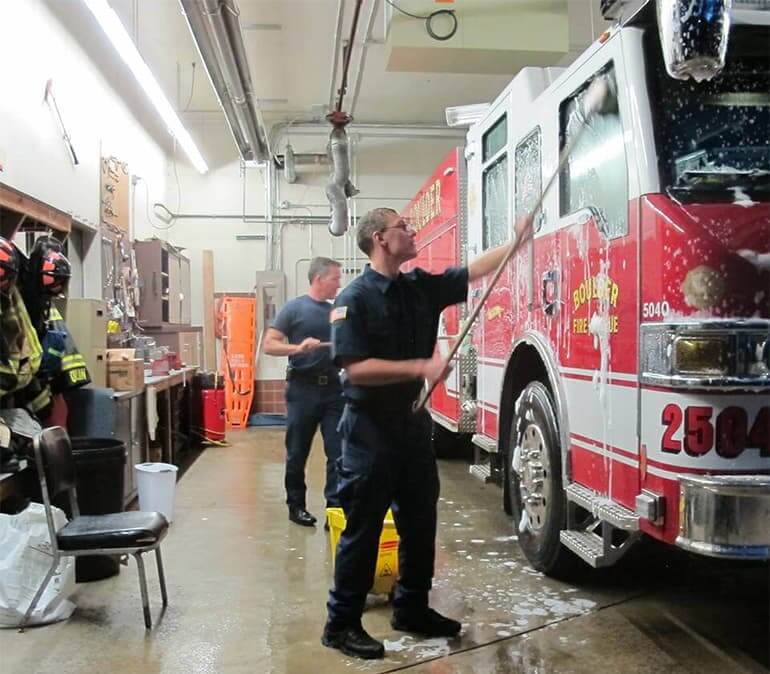
Ian helping local firefighters wash their fire truck.
Another year we asked if we could bring pizza and a birthday cake to have dinner with the firefighters. They even accommodated that!
It is pretty fun to think that in a town our size (100,000 people), a fire truck will pull up next to our car, and the guy driving the truck will call out, “Hey Ian, how’s it going?”
The interesting thing is that because Ian knows the locations of the fire stations in our city, we use them as a basis of where other businesses are located. Our favorite bagel shop is by Station No 1. Our favorite taco place is by Station No 2. We recently went to a wedding at a church none of us had been to before. We looked it up on the computer and found it was right by Station No 6. Ian loved that.
Follow your child’s interests and just know there will most likely be a unique twist to it. You will learn about things you would have never learned about otherwise. If your child’s interest happens to be fire stations, let me know when you meet a firefighter or you learn your response time, whichever comes first!
Lesson #3: Don’t Take Life Too Seriously
I know you have stories to tell about something your child said or did because our children are so funny. What should we take away from this? You should not take life too seriously.
Let’s Wear Helmets in the Car
One afternoon, the whole family decided to run down to the grocery store for a few things, and Ian said, “Let’s all wear helmets in the car.”
I’m thinking, “You can never be too safe.”
Cassie’s thinking, “Really?”
Before we knew it, Larry and Ian started gathering helmets for us all to wear in the car.
Then you have that child who puts on a costume and rides his bike around the neighborhood in the middle of the summer. You wonder what the neighbors will think and then you chuckle about it.
I’ll See You in Court
When Ian was young, I remember wondering if he would ever talk. Then I wondered if he would ever be able to be understood. You know his speech is getting pretty good when you take your child to school, he gets out of the car, and you think he’s going to say “See you later mom,” but instead says, “I’ll see you in court” and slams the door. You look around to see who heard and nonchalantly drive off.
Can I Put an Exhaust Pipe on It?
Ian broke his leg a few years ago, and when we saw that crutches were too tippy, he asked for a wheelchair. A couple of days after we got the wheelchair, Ian asked if we would put an exhaust pipe on his wheelchair. I looked at Larry, then back at Ian and said, “Uhh, sure Ian.” Don’t ask why we have a spare exhaust pipe at our house.
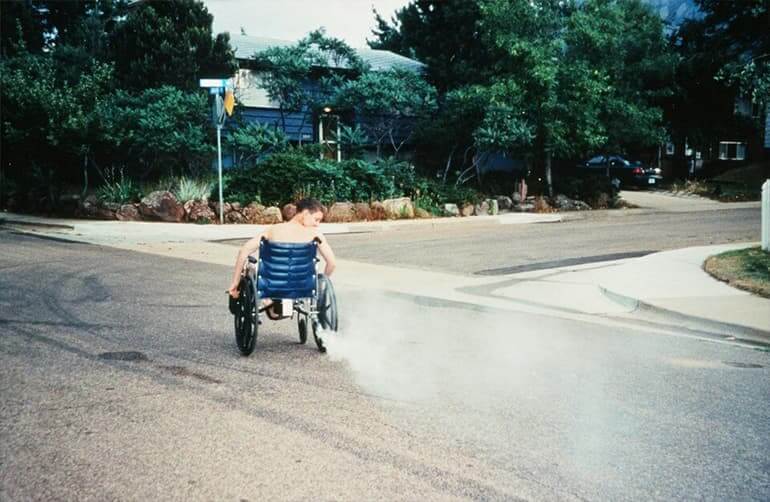
Ian showing off his tailpipe on his wheelchair!
Who Skips?
One time when we were going to the store, Ian was out the door ahead of my daughter, and I saw some people look at Ian and do this kind of chuckle. I looked at my daughter and said, “They’re laughing at him.”
She looked at me, “Mom, he’s skipping. He’s 20 years old, six feet tall, weighs 200 pounds . . . and he’s skipping.”
Sometimes I see Ian, and I forget that he has his quirks. It really is funny. I mean, besides little kids, who skips? Now when I see him skip, I smile.
You’re Never Too Old to Wear a Pink Tutu
Both of my children run in a 10K road race every May. They train with a group of people, some with and some without disabilities. Last year, Ian asked if he could wear a pink tutu for the race.
Like the helmets, costumes, and exhaust pipe, I said, “Sure Ian. I don’t think you’re ever too old to wear a pink tutu.”
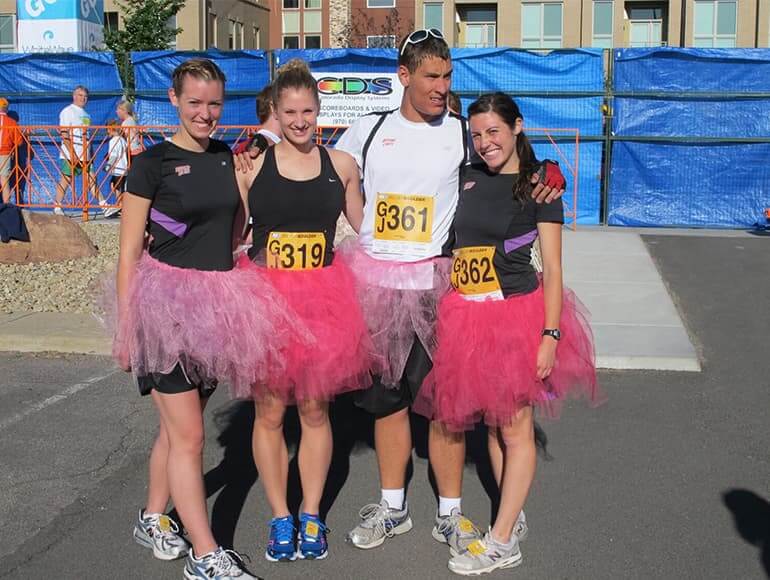
Ian and three friends wearing pink tutus at a 10K event.
“And the best thing he’s ever done for me, is to help me take my life less seriously, it’s only life after all.”
—Indigo Girls – Closer to Fine, 1989
Lesson #4: You Never Know Where You Will Meet the Nicest People
There are some very nice people in this world, and you never know where you are going to meet them. They may be the people you expect like neighbors or friends from school, but they may also come from places you least expect. They may be people you never thought of getting to know, or they may be people who help you through activities that are difficult for your child.
These are the people that Ian has gotten to know and sees as his friends:
- Emily is a (typical) friend and has been since they were in the third grade together. She is out of college now, and she still takes Ian out for dinner when she’s in town.
- Trash collector Mike taught Ian how to work the levers on the trash truck. Juan is our current trash collector and he has taken Ian for a ride in the truck.
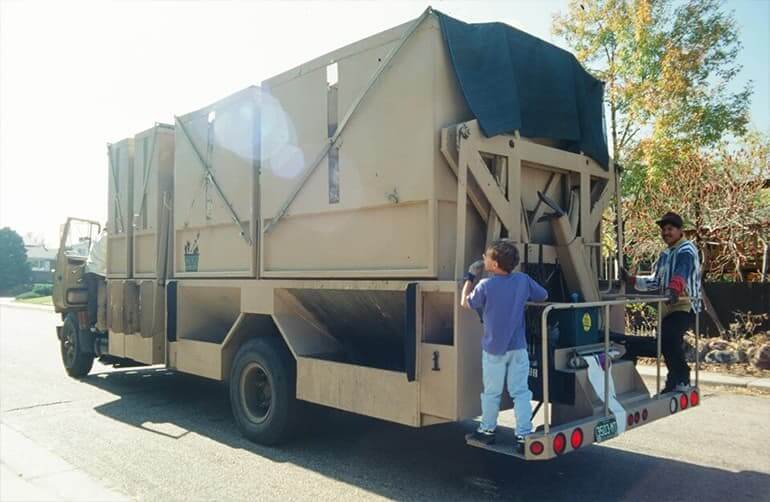
Ian riding on the back of the trash truck with Juan.
- Mail carrier Larry taught Ian how to deliver mail, and he gave Ian a tour of the post office.
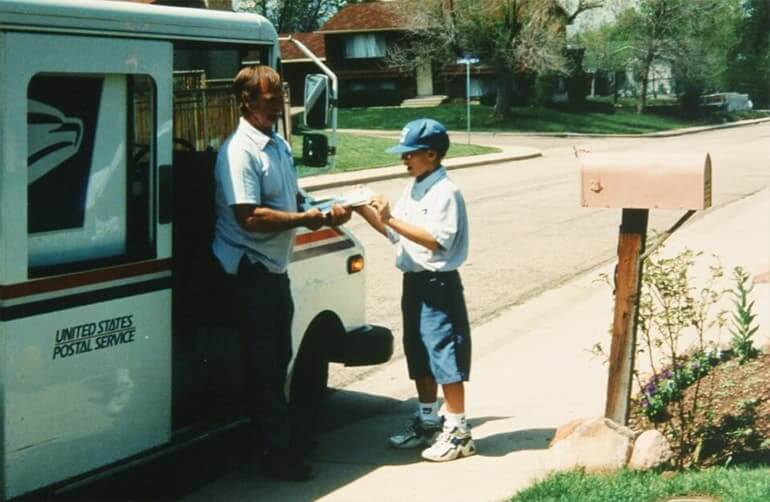
Ian helping the mailman when he was a young boy.
- Wesley cuts Ian’s hair, and she was able to get Ian to tolerate a haircut and a shampoo.
- Dental hygienist Bonnie was the one to get Ian to lie back in a chair, have all his teeth cleaned, and do X-rays.
- Firefighters Tony & Reggie showed Ian the hand signals to use when guiding a fire truck that is backing up. Firefighter Jason gave Ian his old bunker gear.
- The people Ian works with at the grocery store are so nice to Ian that it just warms my heart.
How does Ian respond to all these wonderful people?
- He learns what their favorite soda pop is and takes it to them.
- He learns what their favorite sports team is, buys the team cap, and wears it when he knows he’s going to see them.
- He sometimes buys burritos and doughnuts and takes them to work to give to people.
These are his ways of connecting with people. It is pretty unique and the other people just love it.
Now, let me tell you about Coach Z.
Coach Z
Ian has been interested in football since he was a young boy. When he started high school, I asked the freshman football coach, Coach Z (his given name is John Zadigian) if Ian could be the manager of the team. “Absolutely,” he said.
Ian started going to football practice every day and helping out with the water, but he mostly watched the other guys practice. Before the first game, Ian asked Coach Z if he could dress out for the game. Coach Z paused, “I don’t believe I have ever had a manager dress out before, but I don’t see why not.”
The next day we met Coach Z in the equipment room, and Ian got his helmet, shoulder pads, jerseys, pants, thigh pads, and knee pads — the works. I have never seen Ian so excited in all his life.
Ian showed up at the first game dressed like one of the guys. Watching Ian on the sideline gave Coach Z an idea. Without telling my husband or me, we saw Ian run out to the field toward the end of the game when our team was ahead by many points. Coach Z had talked to the coach on the other team, and they decided to set up a play for Ian.
The ball was hiked, the quarterback turned, and he handed the ball off to Ian. Ian took off running toward the end zone. The players on the other team were diving toward Ian, but they missed him every time. Ian ran into the end zone and spiked the ball. The whole stadium burst into applause and cheers for Ian as he ran along the sideline and high-fived the rest of his team. And the legend began.
Over the last 11 years, Ian has run for over 100 touchdowns.
Never underestimate the impact your child has and will have on other people. Your child will form unique bonds with people — bonds that you may never understand. For the most part, your child brings out the best in other people, and you can’t say that about too many people. You will have your challenges and your ups and downs, but you will work through them. It really will be okay!
Whenever I get down about anything, Ian can always tell, and he comes up to me and says, “It’s going to be okay, Mom.” When I see the world through his eyes, I realize he is right. I just have to do that more often.
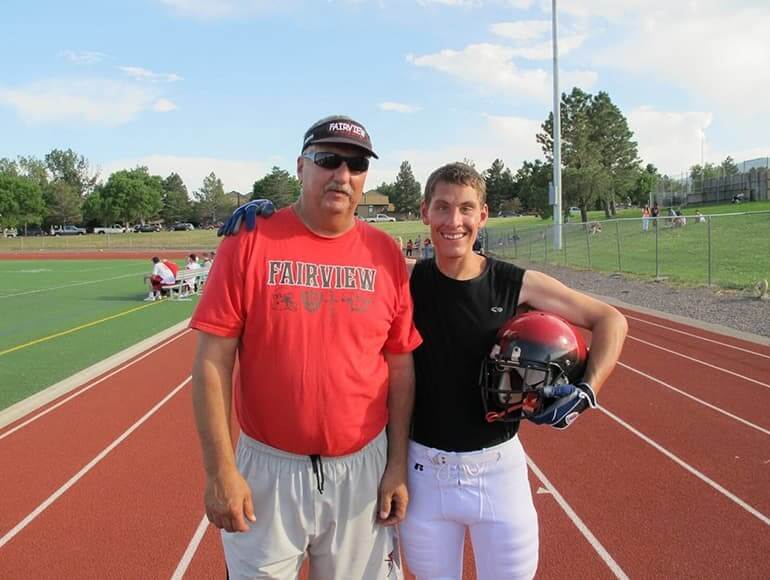
Ian with his football coach, John “Coach Z” Zadigian.
In Closing
- Slow down and take some time each day to see the world through your child’s eyes. It is a pretty nice world.
- Send me an email. I would like to hear what your child’s interests are, or when you meet your first firefighter!
- Tell me how you are taking your life less seriously, or send me a picture with you all sitting in your car with motorcycle helmets on.
- Tell me about the nice people in your child’s life. They are out there.
- Finally, know that you can never have too many costumes or score too many touchdowns.
All you need to know about life you will learn from your child or children. I hope that you won’t just learn to live with Fragile X. I hope you learn to embrace it and enjoy the benefits it has to offer!
about

Jayne Dixon Weber
Jayne served as the NFXF director of community education (and other positions over the years) from 2007 to 2023. She has two adult children, a son with Fragile X syndrome and a daughter. Jayne is the author of Transitioning ‘Special’ Children into Elementary School, co-author of Fragile X Fred, and editor of Children with Fragile X Syndrome: A Parents’ Guide. Jayne likes to read, enjoys photography, and goes for a walk every day.

